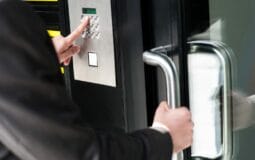If you’re looking to learn more about physical access control, then you’ve come to the right place. Security management is a crucial aspect to consider when running an office or other enterprise building, and physical access control plays a large part in that.
Threats can emerge in many shapes and sizes, so it is essential to have a thorough and secure security system. Physical access control acts as a barrier to prevent unauthorized individuals from accessing a specific space. These controls come in many forms that we see commonly today. They include mechanisms such as magnetic and electronic locks, video management, and visitor badges.
The Trends Emerging in Physical Access Control
The pandemic spurred an increase in touchless solutions to remove contact points in an effort to stop the infection from spreading. However, in some ways, the pandemic also disrupted the progress of access systems as many departments shifted to remote working and remain so now. In a recent survey, over half of the companies questioned are either in the process or have plans to set up mobile access in their facilities.
Mobile is the leading technology currently shaping the developments of physical access control. Despite this development, many companies still rely on out-of-date infrastructure which leaves them open to attacks and with a system that is difficult to manage. Most companies surveyed were implementing physical access control components that were between 3 to 6 years old.
Therefore, the technology of many companies is not equipped for the threats of the modern world. This is reflected in the fact that 36 percent of companies surveyed reported using less secure credential technology in the form of 125 kHz low-frequency proximity cards. These products may be convenient and reliable, but they offer extremely limited privacy and security.
The Various Forms of Physical Security
As previously mentioned, physical access control takes on a multitude of forms. It can be accomplished by another human, such as a guard, bouncer, or ticket checker. It may be implemented by means of technology, such as a cloud-based access control system.
Furthermore, a traditional access system may be through mechanical means such as a lock and key. Of course, over time the flaws of the more traditional methods have come to light. Mechanical locks and keys do not restrict access at certain times, nor do they keep a record of when the door was locked or unlocked. Additionally, the keys can easily be duplicated or fall into the hands of the wrong person. When keys are lost, security is jeopardized until such times as the locks and keys can be completely replaced.
This is where electronic access controls (EAC) come in handy. As in every field, technology is improving, streamlining, and developing processes and systems. The area of physical access is no exception; this is to be expected! As threats evolve and grow in both intelligence and sophistication, the barriers to dealing with these threats must grow and improve too. By staying alert to the threats of today, and developing awareness of the security options available, you can provide a secure working environment for your business.
The Access Control of the Future
The limitations of mechanical access control can be solved by the features of electronic access control. An increased number of credentials is required which greatly improves the security of the location.
The question surrounding electronic access control is whether to choose an on-premises system or a cloud-based solution. Over a third of end-users that were recently surveyed now use cloud management for access control. A recent analysis projects a 35 percent growth in the global market for cloud-based access control systems, with the demand growing annually by 19.8 percent through to 2021.
So, what is all the fuss about?
The Pros and Cons of Cloud-Based Systems
Almost everything these days can be stored “on the cloud”. There are pros and cons when it comes to this solution in the matter of handling access control.
Cloud Perks
- It’s considerably cheaper. The expense is reduced as a local computer server is not required, it’s simply a case of a monthly expense rather than a significantly higher upfront cost.
- It’s easier to deal with maintenance and support because you don’t need to install something on the local computers.
- The cloud service will handle the software upgrades, rather than the staff employed by the end-user.
- Managed services are significantly more secure.
Cloud Pitfalls
- As the system relies on Internet connectivity, when the Internet goes down so does the application.
- There are instances when the cloud service might fail, so that would prove to be both an inconvenience and a vulnerability in terms of security.
- Rather than a one-off expense, there is a monthly subscription cost to be considered and budgeted for.
The Pros and Cons of On-Premises Systems
On the other hand, an on-premises system also has some benefits and drawbacks to be aware of.
On-Premises Perks
- There is no need to be connected to the Internet which may be a requirement for some secure locations.
- It may take a few years, but in the long run, it will be cheaper than a cloud-based system.
- Software that runs on the end-user’s own network is more accessible and will still be available even if the Internet connection goes down.
On-Premises Pitfalls
- The initial setup costs are higher, almost three to five times more expensive than a cloud-based system in some cases. This means it could take several years before you break even
- If your organization has multiple sites, this will require more than one site license which can also increase the expense.
- The software will need to be updated and maintained – this is essential to do as operating systems and networks evolve.
- The security level will depend on what the user can provide on-site so that might prove to be a challenge.



